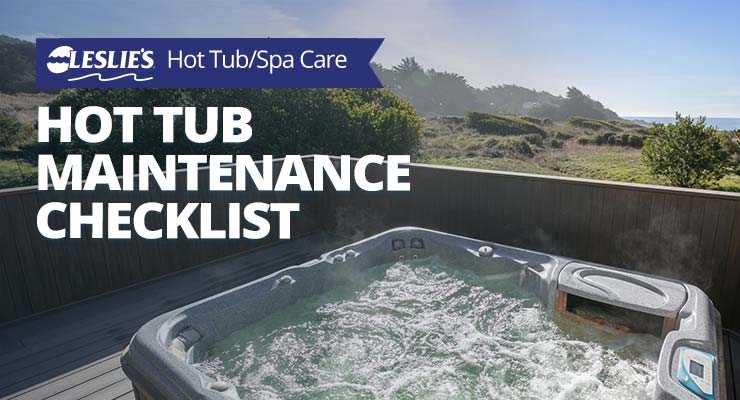
Leslie's Hot Tub Maintenance Checklist
There’s a lot that goes into maintaining a hot tub or spa, but it’s not too complicated once you understand the basics. Really, the hardest part of hot tub maintenance is knowing what to do and how often to do it. Leslie’s is here to help! Today we’ll walk you through the basics of hot tub and spa care, including a checklist of daily, weekly, monthly, and yearly maintenance tasks.
Daily Hot Tub Maintenance
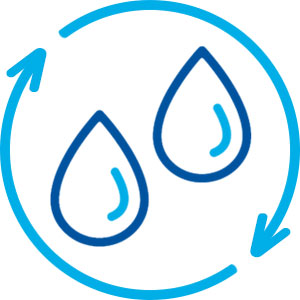
Circulate and Filter Water
The water in your hot tub needs to pass through your filter at least twice daily. This helps prevent algae, removes debris, and keeps your water fresh, clean, and clear. Most portable spas and hot tubs can be automated to do this on their own. If you have an older model or one that’s not able to self-circulate, just turn the pump on for 15–20 minutes a couple times each day.

Check the Cabinet and Cover
Walk around the hot tub, and make sure there are no obvious signs of a problem, such as a water puddle caused by a leak. If you have a hot tub cover installed, check to make sure that it’s fitted securely in place. This doesn't have to be an intense observation. A quick daily walk around the hot tub can help tip you off to a potential issue as quickly as possible.
BONUS TIP: A well-fitting hot tub cover is important for several reasons. For one, the cover’s primary function is to conserve heat energy in your spa or hot tub. A cover that’s not properly fitted can lead to a more costly utility bill each month. Also, a cover prevents a lot of dirt and debris from entering the water. This helps reduce cleaning time, and prolongs the amount of time needed between filter cleanings.

Take the Temperature
A hot tub that’s either not heating or overheating can signal a problem with the electrical components and/or circulation system in your hot tub. Check the digital display or the spa thermometer to make sure the water is within the expected temperature range. If it's not, grab the owner's manual and start troubleshooting, or call a repairman to service your hot tub.
Weekly Hot Tub Maintenance

Test and Balance the Water
At least 2–3 times per week, test the water and rebalance as necessary with the appropriate spa chemicals. If you’re using the hot tub often, test sanitizer levels more frequently. pH should be between 7.4–7.6, Total Alkalinity between 80–120 ppm (parts per million), and calcium hardness between 150–250 ppm. Ideal sanitizer levels in a hot tub are 1.0–3.0 ppm for chlorine, and 2.0–4.0 ppm for bromine.
BONUS TIP: The Leslie’s mobile app can help track water balance trends in your spa or hot tub. It’s free to use, and can even help out with product suggestions to get your water back within proper ranges.

Shock the Water
At least once per week, you’ll need to use quality spa shock. This will properly sanitize the water and get rid of chloramines or bromamines. For hot tubs, you can either use a dichlor shock, such as Leslie’s Chlor Brite, or a non-chlorine shock, such as Leslie’s Fresh ‘N Clear. Both types can be used with either bromine or chlorine sanitizers. The best way to shock your hot tub is to use dichlor once a week, and add a bit of non-chlorine shock each time after you use the hot tub.
Air Out the Cover

To prevent mold and mildew from accumulating on the underside of your hot tub cover, it’s important to remove it from the spa and let it air dry. Allowing the cover to “breathe” and air out for a couple hours once or twice a week will help prolong its lifespan. Having a cover lift will make this a simple, seamless process. If you use your hot tub at least a couple times a week, you can just leave the cover off until the underside has time to dry.
Clean the Hot Tub
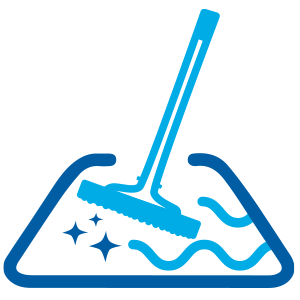
Keep your hot tub free of dirt and debris with a spa wand or battery powered spa vacuum. If you have large debris like leaves floating around in the water, a leaf skimmer is good to have. To prevent scale and scum from accumulating at the waterline, use a sponge with a specially formulated spa cleaning product every couple of weeks. If you don’t have too much trouble at the waterline, just deep clean it once a month or whenever you do your quarterly cleaning and maintenance. Whatever you do, DO NOT use soaps or household cleaners. These can damage the finish on your shell, negatively impact water balance, and introduce sudsy foam into your spa, which is no fun at all. In a pinch, you can use white vinegar in place of a regular spa cleaning solution.
BONUS TIP: Having issues with oily residue in your filter and along the waterline? Get a scum remover to drop in the water. Or, in a pinch, you can also use a clean tennis ball. These will soak up the oils from skin, makeup, lotions, or other oily contaminants and prevent them from sticking to spa surfaces.

Clean the Filter
Most hot tubs need their filter cartridges cleaned at least once a week. This is assuming an average of 2–3 people using it 2–3 times per week. Higher usage may require more frequent cleaning, and less usage means you may be able to go longer between cleanings. To clean the filter cartridge, thoroughly rinse the filter off with a spray nozzle or a filter cleaning accessory. If needed, spray or soak the filter with Cartridge Cleaner to help remove the oils and residues caught in the fibers.
Monthly Hot Tub Maintenance

Get Professional Water Testing
In addition to your regular at-home water testing, it’s a good idea to have your water professionally tested at least once a month. Leslie’s offers a FREE 10-point AccuBlue® water test that precisely measures the complete water chemistry of your hot tub. Our state-of-the-art water testing system precisely measures many aspects of water chemistry that most at-home test strips and test kits overlook completely.
Thoroughly Inspect the Cover

A damaged or deteriorating cover can quickly become a headache. It will decrease the heating efficiency of your hot tub, increase cleaning and maintenance time, get heavy and difficult to remove, and become a dangerous breeding ground for smelly mold and mildew. If you start noticing any issues, such as cracking, warping, water in the foam layer, or other similar issues, plan to replace it with a new hot tub cover as soon as possible. Custom covers usually take at least a few weeks to build and ship, so it's best to plan ahead. You don’t want to find yourself in an emergency situation without a hot tub cover.
Quarterly Hot Tub Maintenance
Clean and Condition the Hot Tub Cover

Most hot tub covers are made of a durable marine-grade vinyl that’s resistant to UV radiation. This makes it ideal for harsh and unforgiving outdoor environments. However, without a little regular care and TLC, the vinyl can dry out, crack, and fade. Use a hot tub cover cleaner and conditioner every 3–4 months to keep it looking like new. Be sure to only use products specifically formulated for hot tub covers or marine vinyl.
Purge the Plumbing
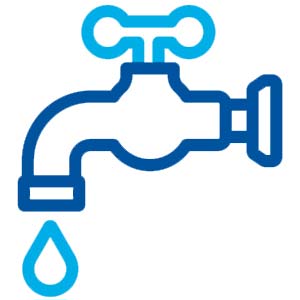
Even the most perfectly balanced and sanitized hot tubs can hide some pretty nasty gunk in the plumbing. Over time, organic contaminants like sweat, lotions, cosmetics, and body oils can build up in the lines to create layers of biofilm, which can quickly become a breeding ground for bacteria. Just before you plan to drain your hot tub, add an enzyme product, such as Spa Purge or Jet Clean, and turn on the jets. Your water will more than likely turn murky as the unsightly biofilm is purged from the plumbing. Making this part of your regular maintenance routine will keep your hot tub cleaner and healthier. It will also help keep your equipment running efficiently.
BONUS TIP: Regularly using an enzyme product, such as Spa Perfect, can help break down the oils and organic debris in the water. This prevents biofilm buildup from taking over your plumbing in the first place. It also prevents scum and stains at the waterline, enhances the power of your sanitizer, and keeps your filter cleaner longer. Add this to your weekly hot tub regimen to cut down overall maintenance time.
Drain and Refill the Hot Tub

Since hot tubs hold quite a bit less water than a swimming pool, they eventually reach a point where the amount of contaminants and chemicals in the water make it increasingly difficult to maintain sanitary, clean, and clear water. It’s important to drain the water every 3–4 months to keep the water fresh. This is usually a good time to do other large maintenance tasks, including purging the lines (see previous paragraph), replacing jets, performing major repairs, or deep cleaning the shell. When refilling the hot tub, a pre-filter can be helpful if you live in an area with particularly hard water. Balance and sanitize the water after each refill, and you’ll be ready to relax again in no time.
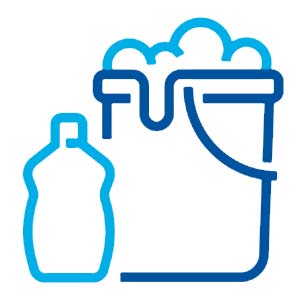
Soak the Filter
While you’re busy deep cleaning the hot tub, it’s a great time to soak your filter cartridge(s) in a filter cleaning solution. Doing this can increase the lifespan of your filter by removing debris and buildup that’s missed during the weekly spray and rinse. Soak the filter for a few hours or overnight in a bucket of solution, then rinse the filter thoroughly before reinstalling it in the hot tub.
Yearly Hot Tub Maintenance

Replace Filter Cartridge(s)
Most hot tub filter cartridges have about a 12-month lifespan, depending on frequency of use. Hot tubs that get used a lot should get a new filter sooner, and hot tubs that don’t get used often can use the same filter for a little while longer. Every time the filter is cleaned, the fibers that make up the filter get looser and lose efficiency. Eventually, they just don’t do the job and let a lot of particles through. They also get progressively more stained and are increasingly difficult to clean, even with regular soaking.
Open the Spa Cabinet
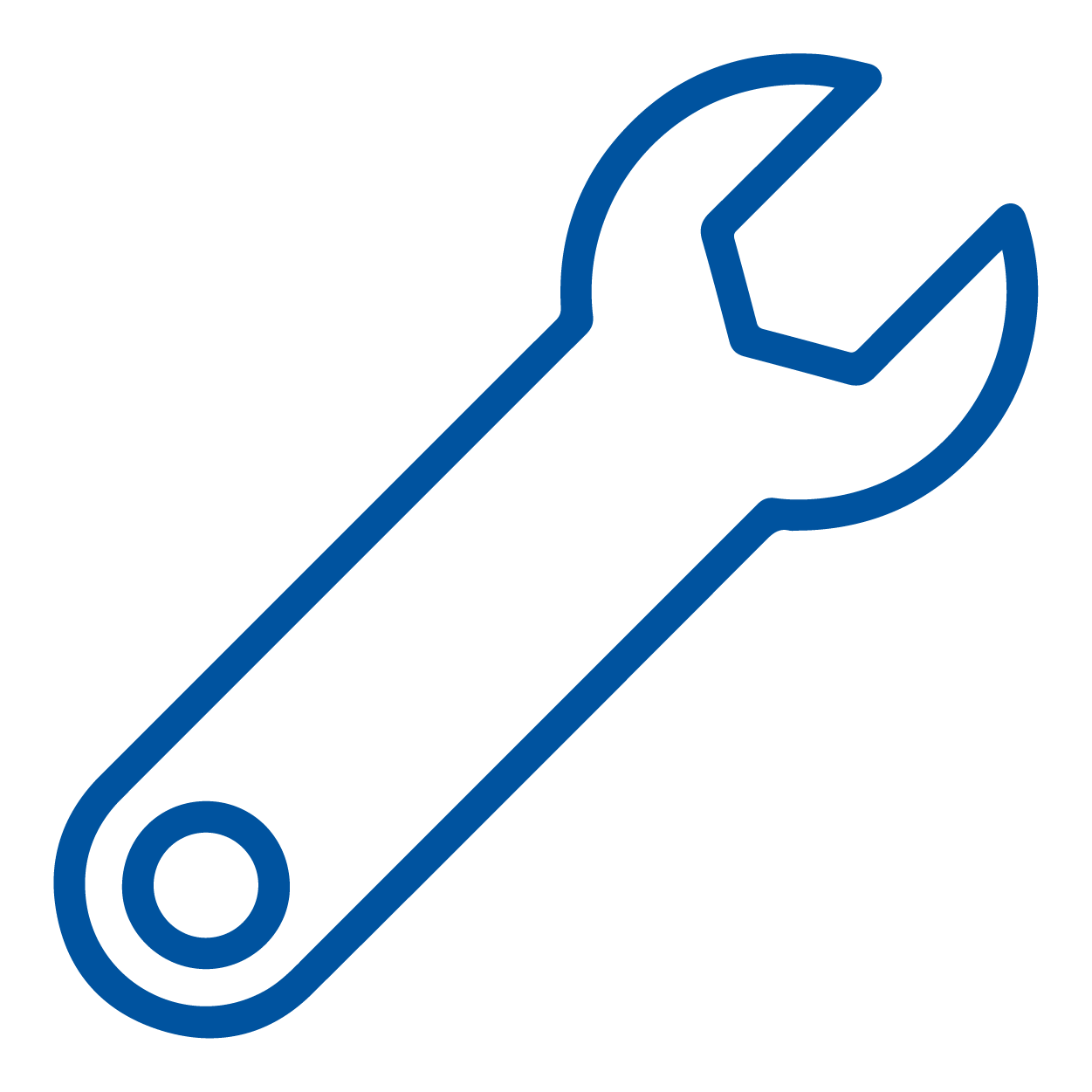
A lot can happen when you’re not looking! At least once a year, it’s a good idea to open up the spa cabinet and take a peek inside. Make sure there are no pests taking up residence, and thoroughly inspect the wiring for signs of chewing or damage. Take a look around to see if there are any slow leaks causing rot or other issues inside the cabinet. Now is also a good time to do a bit of routine maintenance on your pump, such as lubricating and/or replacing gaskets and O-rings. If you know of a reliable maintenance person, you can hire them to service your hot tub equipment or repair any plumbing and electrical issues for you.
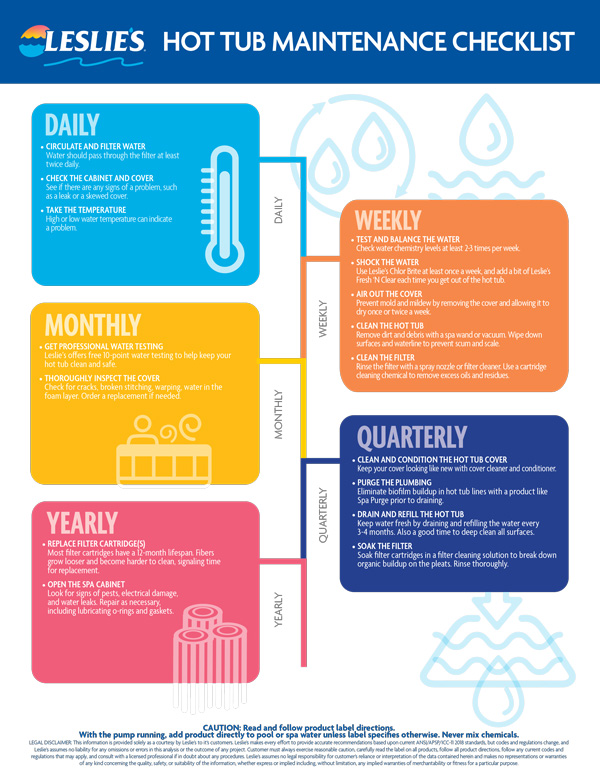
Download this printable version of the Leslie's Hot Tub Maintenance Checklist and keep it available for whenever you need it.
Need more help understanding hot tub chemistry? You'll want to watch this video below. You can also check out the in-depth blog article, Hot Tub Care 101.
Still have questions? We can help! We're here to help you understand all the ins and outs of your hot tub so you can focus on the most important part: enjoying it! Stop by or call your local Leslie's store to speak with one of our knowledgeable pool and spa associates.